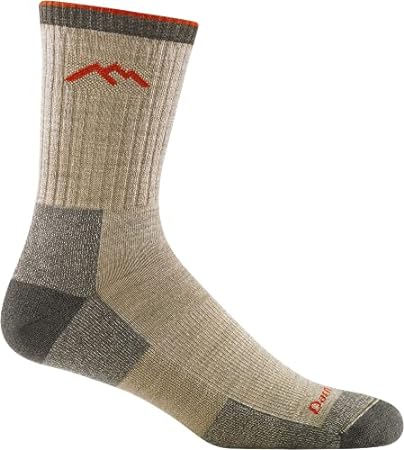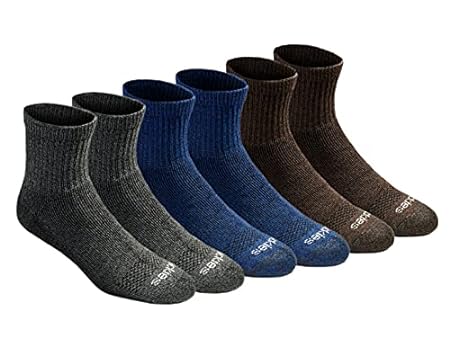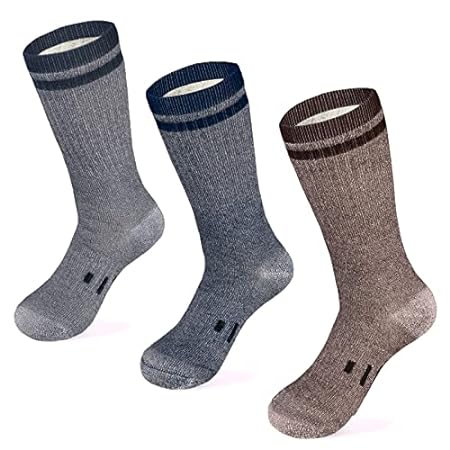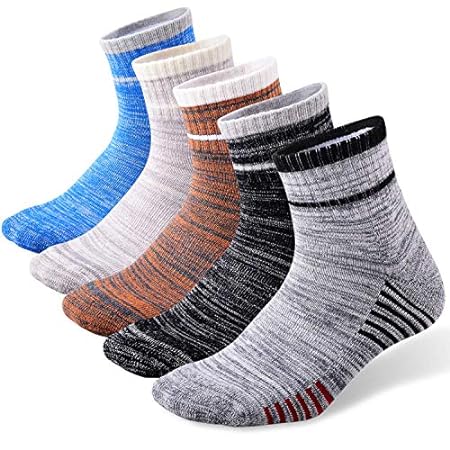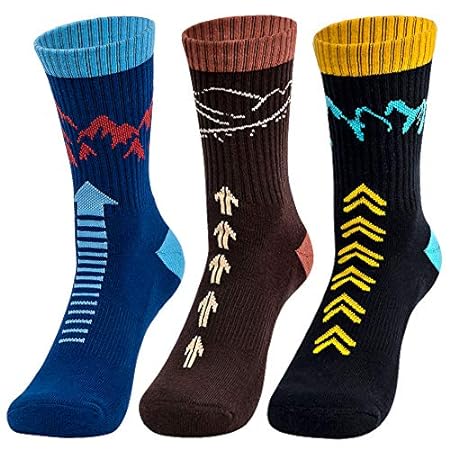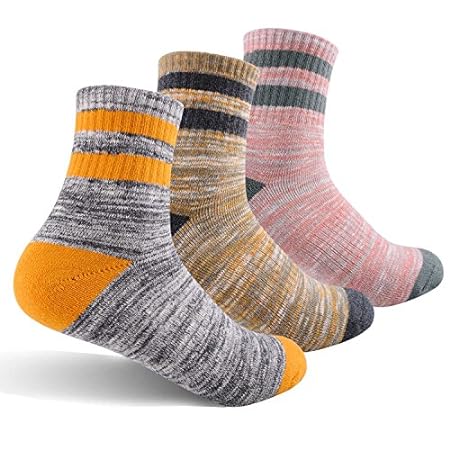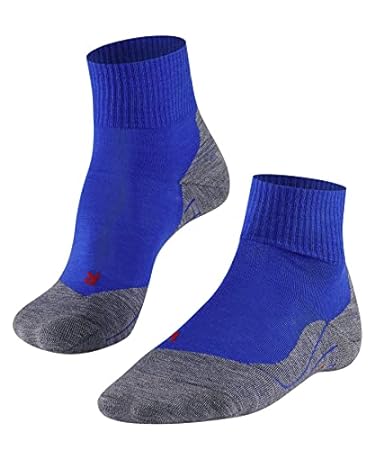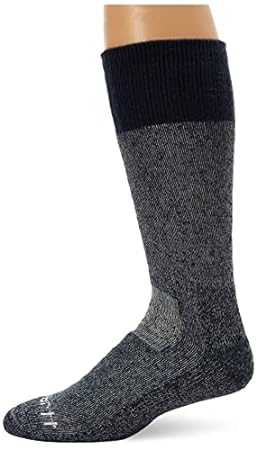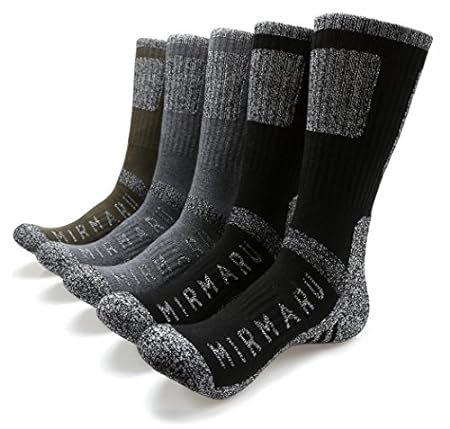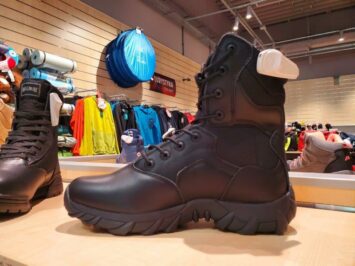As a fellow hiker, we know how your feet feels after a day of hiking. While it is normal to experience mild pain and aches after hiking all day or walking a long distance, wearing the right hiking socks can help provide much more comfort. The best hiking socks protect your feet from blisters and hotspots, allowing you to comfortably enjoy every moment of your outdoor adventure. In this review, we’ll share some of the best hiking socks out there for fellow seasoned hikers like you and me wo are looking to stay comfy on your next hike!

Quick Navigation
ToggleWhat are the Best Hiking Socks?
We have compiled for you the top 12 Best Hiking Socks in 2024. In this article we go through the products that we have used ourselves, checked what other users thought about them and we ranked them accordingly.
With years of experience with socks for hiking and having used several hiking socks you can trust our review.
Moreover, you can scroll to the end of this review to see our mini buying guide as well as the answers to some of the frequently asked questions about hiking socks.
1. Darn Tough Hiker Micro Crew Cushion Sock
| Specs |
|---|
| Price: 💲💲💲 (fewer 💲 = cheaper) Number of Pairs: 1 Material: 61% Merino Wool, 36% Nylon, 3% Lycra Spandex Sizes (US): S-XXL |
The Darn Tough Hiker Micro Crew Cushion Sock is made from a combination of fabrics that are designed to keep your feet comfortable and warm.
It is made from 61% Merino wool that protects your feet in any weather. It is naturally antimicrobial, meaning that it repels bacteria and odor. It provides extra comfort by wicking moisture, helping you stay dry outdoors. The sock has ribbed support that prevents it from slipping and bunching. It is perfect for rugged conditions as it is designed for the toughest trail. Its high-density knitting process makes it comfortable and durable without bulking.
Pros
- Made from quality Merino fabric
- Antimicrobial and repels odor and bacterial
- Moisture-wicking and quick-drying
- Ribbed support to prevent slipping and bunching
- Fully padded to create a soft landing while keeping your feet warm
- The snug fit keeps it on your leg
- Lifetime guarantee
Cons
- Might shrink after washing
- If you have big feet, the snug fit might be a bit tight
2. Peruvian Link Alpaca Socks
| Specs |
|---|
| Price: 💲💲💲💲 (fewer 💲 = cheaper) Number of Pairs: 1 Material: 50% Alpaca, 35% Acrylic, 8% Spandex, 7% Nylon Sizes (US): S-L |
The Peruvian Link Alpaca Socks is made from a combination of materials, mostly Alpaca wool that is warm, soft, and comfortable. It also uses spandex and nylon fibers for a stretchy and snug fit.
It uses aloe-infused alpaca wool that keeps your feet soft and prevents athlete’s foot. Its moisture-wicking and quick air drying properties make it ideal for quick use. They are designed to keep your feet protected in any weather condition and it is durable and does not fray unless washed in hot water. In this review, the Peruvian Link Alpaca Socks has been selected as the best premium buy. However, while it costs a lot, the performance makes it worth every dollar spent.
Pros
- Made from soft fibers for a comfortable experience
- Uses aloe-infused alpaca wool to keep your feet soft and prevent blisters
- Breathable and perfect for any weather condition
- The quick air-drying process makes it ideal for use
- Made thick to provide extra cushion
Cons
- The extra elastic may make them stretch a little more than expected
- Premium pricing
3. Dickies Dri-Tech Mens Socks
| Specs |
|---|
| Price: 💲💲💲💲 (fewer 💲 = cheaper) Number of Pairs: 12 Material: 54% Polyester, 45% Cotton, 1% Spandex Sizes (US): 5-8, 6-9, 10-12, 13-15, 15-17 |
When deciding what’s best for your feet it’s all about the activity. If you are an avid hiker then a much thicker sturdier sock is more important, the color and style is secondary. If it’s something for the office or everyday wear then comfort along with style is important. The Sock Amazing bamboo unisex sock are designed for everyday use in as varied circumstances as this is possible. They’re soft and odor-resistant, so you can keep them on all day long without worry. They also come in many different colors to fit any outfit or event for both adventure and business settings. However, they are only 90% bamboo and some reviews say they’re a bit tight on the calves.
We find that it’s a universally good choice, but it comes at the cost of being less environmentally friendly than other bamboo socks.
Pros
- Has ventilation channels for increased air circulation
- Its arch-compression keeps the sock in place
- It provides full-cushion comfort for the feet and in-step support
- Fast dry technology
- Best budget buy
Cons
- Wear and tear from frequent use is quick
- Comes with a lot of lint that takes a while to remove
4. Meriwool Merino Wool Socks
| Specs |
|---|
| Price: 💲💲💲 (fewer 💲 = cheaper) Number of Pairs: 3 Material: 75% Merino Wool, 15% Nylon, 10% Stretchable Elastic Sizes (US): S-XL |
The Meriwool Merino wool socks are lightweight and breathable. It offers support for your feet in any weather condition and is thermally insulated to keep your feet warm in wet and cold environments.
Made from 75% Merino wool, it has 10% stretchable elastic that keeps it snug on your feet, preventing slipping and bunching. The sock has the natural odor-resistant property of merino wool and moisture-wicking properties that keep you dry and comfortable. It is soft, lightweight, and does not irritate. The material regulates your body temperature so that you are never too cold or hot.
Pros
- A ribbed knit design for elasticity
- Insulated for maximum protection in a cold environment
- The odor-resistant property keeps you comfortable in active use
- Water-resistant so it keeps your feet dry and prevents blisters
- Arch-compression keeps your feet comfortable for long use
- Lightweight
Cons
- They are thick and large so they take up a lot of space when packed
5. Feideer Wicking Socks
| Specs |
|---|
| Price: 💲💲 (fewer 💲 = cheaper) Number of Pairs: 5 Material: 75% Cotton, 22% Polyester, 3% Spandex Sizes (US): 6.5-10.5, 10-13, 12.5-15 |
Made from 75% cotton, 22% polyester, and 3% spandex, the Feideer Wicking Socks are notable for their ventilation and moisture-wicking properties. It is fully cushioned to provide comfort and prevent blistering while reducing friction and absorbing shock. It has excellent elastic features that provide flexibility; including an elastic arc brace for movement range. The elastic ribbed cuffs keep it snug and prevent bunching without causing friction. The socks are breathable and have a mesh ventilation feature that wicks moisture and keeps your feet dry to enjoy a comfortable day outdoors.
Pros
- Mesh ventilation with precision knit for comfort
- Fully cushioned to absorb shock and reduce friction
- Elastic arc brace for flexibility
- Durable and wear-resistant
- Colors do not bleed during wash
Cons
- Might not fit if you have wide feet
- Fabric felt irritating to some reviewers
6. Time May Tell Mens Hiking Socks
| Specs |
|---|
| Price: 💲 (fewer 💲 = cheaper) Number of Pairs: 3 Material: 80% cotton, 20% polyester Sizes (US): 6-9, 9-12 |
The Time May Tell Men’s Hiking Socks is designed for comfort, flexibility, and warmth. Made from 80% cotton and 20% polyester, it wicks moisture and keeps your feet dry and cool all day. It features a terry design at the bottom that serves as a cushion while the soft treatment prevents blisters and reduces friction. It has arch support on the instep that prevents displacement and a reinforced toe that keeps it comfortable while you are outdoor. Not spending time outdoors? The Time May Tell Men’s Hiking socks is also versatile as it can be worn with casual shoes for partying or daily living.
Pros
- Soft treatment of socks reduces friction
- Terry design on sock bottom provides cushion
- Elastic compression supports the shin
- Lengthened welt reduces slipping or bunching
- It can be matched with sporty or casual shoes for any occasion
Cons
- Only comes in two sizes
- Shrink easily
- May leave fuzz on your feet
7. FEIDEER Multi-pack Women’s Hiking Socks
| Specs |
|---|
| Price: 💲 (fewer 💲 = cheaper) Number of Pairs: 3 Material: 75% Cotton, 22% Polyamide fibre, 3% Spandex |
If you are looking for a budget-friendly option, FEIDEER Multi-pack Women’s Hiking Socks might be the best choice. Unlike Meriwool, they go for a few dollars less but are still stylish and very functional. For those with high-volume feet, they might make a good pair as they are lightweight enough to ensure your boots do not feel tight while also keeping the feet warm in cold environments. Something else hikers might like about these socks is that they offer blister protection for long hours of trekking. The fabric is thick and cozy to minimize friction and rubbing by your boots. However, the elastic closure at the top may feel a little tight for some users and might cause discomfort along the way.
These socks have a lightweight construction that makes them ideal for hot weather hiking. However, some users noted that they shrink after washing which affects their size.
Pros
- Reinforced heels and toes for durability reduced friction,
- Tightly-woven and thick for blister protection,
- Budget-friendly,
- Lightweight with excellent elasticity, Comfortable fit for all sizes
Cons
- Limited colors to choose from,
- Elastic closure is too tight,
- Shrinks after washing
8. Falke Merino Wool Mens Socks
| Specs |
|---|
| Price: 💲💲 (fewer 💲 = cheaper) Number of Pairs: 1 Material: 40% Polypropylene, 35% Virgin Wool, 25% Polyamide Sizes (US): 6.5-8.5, 9-10, 10.5-11.5, 12.5-13.5 |
Made from a blend of fabrics, including merino wool, the Falke Merino Wool Men’s Socks offers comfort and style for easy hiking and daily activities. It is ultralight with light cushioning that makes contact with shoes frictionless. It also has superior thermal insulation, performs rapid moisture-wicking, and regulates the temperature of your feet. With its triple-layered structure, the Falke Merino Wool Men’s Socks prevents blisters by quickly moving moisture from your feet and allow the circulation of cool air.
Pros
- Triple-layered for moisture wicking
- Light cushioning for comfort and adjusted protection
- Thin padding on the heel to avoid slippage
- Toe box and cushioning for a snug fit
- Quick-drying
Cons
- Only suitable for easy hiking trips
- It may lose elasticity after several washes
9. Carhartt Men’s Cold Weather Boot Sock
The Carhartt cold weather socks absorb moisture keeping your feet dry and comfortable.
In freezing weather, they keep your feet warm, even if you’re trudging in deep snow. The Carhartt cold weather socks are cushioned at the foot sole, giving you padded protection even as you walk indoors without shoes. The woolen material keeps away odor so that you don’t have to change during the day. Machine washable, making cleaning easy for you. The socks are durable, and you may stay for a long time before requiring new ones. Sizing appears to be an issue as you may receive large socks while ordering a small size.
Pros
- Sock absorbs moisture,
- Very warm even in extreme cold,
- Protects feet against odor,
- Made from a long-lasting material
Cons
- A bit lose even with a recommended size,
- Too thick to wear comfortably without getting too hot
10. CloudLine Merino Wool Hiking Socks
| Specs |
|---|
| Price: 💲💲 (fewer 💲 = cheaper) Number of Pairs: 1 Material: 63% Ultra soft merino wool, 30% Nylon, 7% Spandex Sizes (US): M-XL |
The CloudLine Merino Wool Hiking Socks is made from lightweight merino wool and is designed for long hikes and long-lasting comfort. It has reinforced cushion zones that make it durable and provide the softness your feet need outdoors. It is both stylish and functional as the vibrant colors make you look good while its antimicrobial properties keep your feet fresh and ward off smell. It also has quick moisture-wicking properties that keep your feet dry all day long. If you ever need to wash it while on a trail, the quick-drying feature ensures that you are not delayed. The sock features arc support to reduce blisters and soreness. However, some have mentioned that it may be a bit too tight around the calf.
Pros
- Antimicrobial properties keep your feet fresh
- Lifetime guarantee from the manufacturer
- Can be worn for multiple days outdoors
- Wider toe area for extra room in hiking boots
- Quick-drying and odor-resistant
Cons
- May be tight on the calf
- Feel a bit stiff at first
11. Danish Endurance Merino Wool Socks
The Danish Endurance Merino Wool Socks are padded underfoot to provide comfort and reduce blisters caused by friction. They come with integrated ventilation zones that increase breathability and keep your feet dry.
They are ideal for active use and support your feet during outdoor activities like skiing, hiking, and trailing. The socks are unisex and come in a range of vibrant colors to keep you stylish while being comfortable.
Pros
- It comes in a range of stylish colors,
- They are unisex and have kid sizes,
- It has extra underfoot padding to support active use,
- Integrated mesh vents for airflow,
- It has a seamless toe design to prevent uncomfortable rubbing
Cons
- Actual sizing differs from displayed size,
- It has a smaller wool content than most socks,
- It needs to be washed before first use,
- It does not have enough arch support
12. Mirmaru Trekking Socks
| Specs |
|---|
| Price: 💲💲💲 (fewer 💲 = cheaper) Number of Pairs: 5 Material: 55% Combed Cotton, 40% Polyester, 2% Spandex Sizes (US): L-XL |
The Mirmaru Trekking Socks is one of the best hiking socks to prevent blisters and it is perfect for hiking, trekking, and a range of outdoor activities. It is made from a combination of fabrics that are blended for durability and strength while keeping your feet warm and dry. The socks feature high-density fibers and cushioning in the underfoot area that provides comfort and protects against blisters caused by friction. It has med-compression and elastic features that protect and support pressure points while the compressed top holds the sock snugly on the calf.
Pros
- Reinforced underfoot for added comfort
- Med-compression to protect pressure points
- Extra cushion finish provides extra comfort for feet
- Breathable fibrous materials for improved airflow
- Elastic arc for support, stability, and flexibility
Cons
- Actual size may differ from displayed size
Verdict
To summarize, we have gone through dozens of hiking socks and decided that 12 are worth your consideration. Out of these, the absolute Best Hiking Socks is Darn Tough Hiker Micro Crew Cushion Sock which we highly recommend as our overall best.
If money is not an issue, you can consider Peruvian Link Alpaca Socks as this is our Premium Pick.
Otherwise, there’s no shame in spending prudently, Dickies Dri-Tech Mens Socks is the Budget Option.
Our other reviews you may find useful in your research:
What You Should Know Before Buying hiking socks
Fabric
Hiking socks are made from fabrics such as merino wool, nylon, and polyester. Cotton often doesn’t make for a good hiking sock as it is extremely absorbant and does not dry quickly, resulting in chafing throughout the day.
Merino Wool
Named after a highly prized sheep in harsh mountain environments, merino wool is popular for its moisture-wicking features as well as the comfort it provides. It is also breathable and regulates temperature. Since it takes longer to build up a stink, it allows for long days of wearing like hiking trips.
Ultra-Soft Merino Wool
Socks made from ultra-soft merino wool fabric do not itch. The fabric keeps your feet comfortable and helps you keep warm on your hiking expedition. They also have odor-resistant qualities and most manufacturers give a lifetime guarantee for them because of the quality.
Nylon
Also known as polyamide, Nylon is the number one synthetic fiber in the world. It is most popular for its strength and durability while being water-resistant and abrasion-proof, hence a popular componet in socks and outdoor clothing manufacturing.
However, the downside to it is that it does not absorb moisture from the skin and it is not breathable. This means that sweat is trapped against the skin and there is no free airflow. Therefore, wearing socks made from nylon for a long period can increase the risk of fungal infection and odor build-up. Most manufacturers combine nylon fabric with others for elasticity and durability.
Lycra Spandex
Lycra spandex is a popular elastic fiber that has a strong resistance to stretching. It is usually mixed with other fabrics at a 3%-10% ratio for flexibility and elasticity. Socks with lycra spandex fibers fit snugly and can maintain their shape over a long period.
Alpaca
Alpaca wool fabric is softer and more comfortable than ordinary wool because each fiber length is shorter. It is naturally hypoallergenic, making it perfect for sensitive skin. It has both moisture-wicking properties and an insulator for temperature regulation.
Virgin Wool
Virgin wool fiber is the product of a lamb’s first shearing. It is the finest and softest wool produced. The term is also used for wool gotten from an adult sheep that has not been processed, dyed, woven, or used in any manner. Like all wool, socks made from the virgin wool fiber are soft, odor-resistant, and have moisture-wicking properties that help to keep your feet dry and fresh outdoors.
Acrylic
Another fabric for making hiking socks is Acrylic. It costs less than natural fibers as it is synthetic. It is popular for being soft and lightweight while providing some warmth. It also has moisture-wicking properties. While the acrylic material is wrinkle-resistant and does not fade, it is not as durable as other fabrics and it can cause itching. This is why most manufacturers blend it with other materials, especially natural fibers.
Spandex
Many hiking socks have a small percentage of the spandex fabric added to them. This is because it is elastic and helps the socks to retain their shape by keeping the rate of wrinkling or bunching to the barest minimum.
Cotton
Cotton is popular around the world as the softest and most comfortable all-natural fabric. However, on its own, it is not an ideal fabric for outdoor adventures because it dries slowly, absorbs moisture, and has no insulation.
Many socks manufacturers blend it with other fabrics because it is comfortable.
Combed Cotton
Combed cotton fabric is a variant of regular cotton that is combed. After combing, the fibers are left long and straight without impurities, making the fabric softer and stronger than regular cotton. This also makes it ideal for sensitive skin.
The fabric is also more durable and has both quick-drying and odor-resistant properties. Because it is more expensive than conventional cotton, combed cotton is used for premium fabrics and socks.
Polyester
Polyester is a durable synthetic fabric that wicks moisture and is resilient for withstanding the wear and tear of the outdoors. It dries quickly and insulates. Alongside being wrinkle-resistant, the fabric is long-lasting and it fades slower than the cotton fabric. The downside to the polyester fabric is that it is not breathable, so sweat cannot evaporate from the feet. It is also not the best option for sock fabric if you have sweaty feet. So, most manufacturers blend it with other fabrics for the durability it offers.
Polypropylene
Also known as Olefin, Polypropylene is a synthetic fiber that is known for its durability. It is lightweight, wicks moisture, and is stain-resistant. It also has a better thermal insulating power than other synthetic fibers.
It is mostly used for sports socks because it wicks sweat from the feet and is quick-drying, leaving your feet warm and dry.
Polyamide
Like polyester, polyamide is a synthetic fiber that is abrasion-resistant, durable, and is designed to absorb and wick moisture. It is also stretchy and wrinkle-resistant. The polyamide material is soft to the touch and comfortable. Compared to other raw materials for creating textiles, it has the highest abrasion-resistance. It is mostly used for socks because it does not pile and can stay snug on the feet. In making the best hiking socks, manufacturers use a combination of these materials because each material has its properties, and combining them improves the functionality and quality of the socks produced.
Padding
Hiking socks come with padding on the heel and ball of the feet. This is to provide protection and cushioning when you are on a trail. To create padding, manufacturers weave materials like acrylic that are suitable for long-wearing into these areas or increase the density of the weave. However, be sure that the amount of padding in your selected socks does not make your shoe too tight.
Height
Choosing the right height for your socks is usually a matter of personal preference or style. Hiking socks come in various heights ranging from short, where it does not show above your shoes, to high, where it is tall enough to reach your knees. However, I recommend socks that are at least mid-length or taller than the cuff of your hiking boots. This is because taller socks will protect your skin from directly rubbing against your shoe cuff.
Fit
Getting the right sock fit will make your hiking even more enjoyable. If your socks are too small, they can cause sock spillage or create pressure points. If they are too big, they will have wrinkles that rub and cause blisters on your feet.
To get the perfect hiking socks to prevent blisters, you need to know the size of your foot, not your shoe. This is because sometimes, your shoe size may be one size up, leading you to buy large socks. If you do not know your foot size, measure your foot and see a sizing chart or check using an online sock size converter. If your foot is between sizes, order a size down to avoid having excess sock material.
Questions and Answers About hiking socks
Do I need sock liners for hiking?
As seasoned hikers, we’ve come to understand that the right pair of socks can make or break your outdoor experience. Regardless of the activity, you need to prioritize your foot comfort and health, and there’s nothing quite like the embrace of wool socks to achieve this. Wool stands out from other materials due to its soft texture and superior insulating capabilities. It also offers impressive moisture-wicking and odor-resistant properties. The ideal wool socks envelop your feet in warmth and comfort, irrespective of the season. Our heavily-researched list below based on true reviews by seasoned hikers will help you find some of the best wool socks for hiking available online.
How long do hiking socks last?
It depends on the type of material and how often you wash your socks. Polyester and merino wool are quite durable, and it might take some time before you need to replace them. Nevertheless, if you have only a few pairs and have to wash regularly, your hiking socks might wear out quicker than you anticipated.
How do you keep feet from sweating while hiking?
Absorbant socks are a great way to keep your feet from sweating profusely while hunting. If your socks are breathable and able to absorb the sweat, you won’t feel wet during your hunt. You can also apply some anti-perspirant sprays to your feet before putting them in your socks to reduce sweat and odor during your hunting trip.
Does wearing 2 socks help prevent blisters when hiking?
Wearing 2 socks helps to prevent blisters by reducing friction with your foot. When you wear 2 pairs of socks, the friction occurs between the socks and not between your skin and socks. Wearing an inner sock has the added benefit of wicking moisture from your foot, making your skin less prone to damage, while the outer layer absorbs moisture and provides cushioning.
How thick should my socks be?
The thickness of your socks depends on the fit of your chosen hiking boots. If you have low-volume feet, you should get thicker socks, while thinner socks are perfect for a high volume foot.
